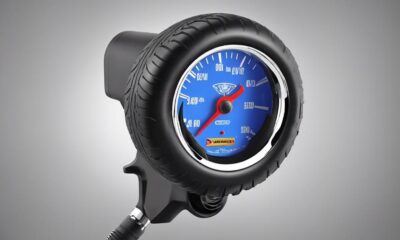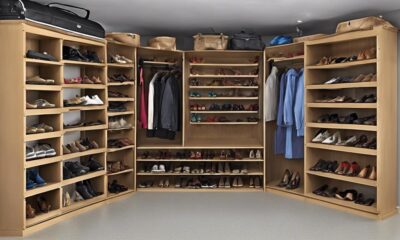Beginners Guides
What Paint to Use on Denim Jacket
2025

When it comes to personalizing a denim jacket, the paint you select can have a significant impact.
We've all been there – standing in front of a wall of paints at the craft store, feeling overwhelmed by the options and unsure which one will give us the best results.
But fear not, because we're here to guide you through the labyrinth of paint choices and help you make the perfect selection for your denim jacket masterpiece.
Whether you're aiming for a bold, graphic design or a subtle, vintage vibe, the right paint can elevate your jacket from ordinary to extraordinary.
So, let's dive into the world of denim jacket painting and unlock the secrets to creating a wearable work of art.
Key Takeaways
- Consider durability and color vibrancy when selecting fabric paints.
- Look for fabric paints formulated specifically for denim or heavy fabrics.
- Opt for colorfast fabric paints to prevent fading or bleeding.
- Choose paints that have been tested for resistance to light, washing, and friction.
Fabric Paints for Denim Jackets
When choosing fabric paints for denim jackets, consider the durability and color vibrancy needed for the design to withstand the wear and tear of everyday use.
Paint compatibility is crucial to ensure that the fabric paint adheres well to the denim material, preventing peeling or cracking after application. Look for fabric paints specifically formulated for use on denim or other heavy fabrics, as they often contain special binders that promote adhesion and flexibility.
Additionally, color fastness is a key consideration to prevent fading or bleeding of the design over time. Opt for fabric paints that are labeled as colorfast or have been tested for their resistance to fading when exposed to light, washing, and friction. This will help maintain the vibrancy and integrity of the design on the denim jacket.
Acrylic Paints and Techniques

Exploring various acrylic painting techniques allows artists to achieve diverse textures and effects on denim jackets, enhancing the visual appeal and individuality of the designs.
When painting denim jackets with acrylics, it's essential to consider the fabric's unique properties. Unlike traditional canvas, denim has a textured surface, which can affect the application and appearance of acrylic paints. To ensure optimal adhesion and vibrancy, it's advisable to start with a fabric medium or primer specifically designed for denim. This prepares the surface for color application and helps prevent stiffness.
Color blending on denim presents a captivating challenge. Due to the fabric's weave and texture, colors may appear differently compared to painting on a smoother surface. Techniques such as dry brushing, stippling, and layering can be employed to create depth and dimension, transforming the denim into a dynamic canvas.
Additionally, experimenting with transparent and opaque acrylics can yield intriguing results, as the denim's inherent color and texture subtly interact with the applied pigments.
Mastery of acrylic painting on denim involves understanding how to harness these unique characteristics to produce captivating and enduring designs.
Specialized Paints for Unique Effects
Mastering the art of painting denim jackets with specialized acrylic paints opens up a world of creative possibilities, allowing artists to achieve unique and captivating effects that enhance the fabric's texture and individuality.
When aiming for custom designs, consider using fabric paints that are specifically formulated for denim. These paints are designed to adhere to the fabric's surface, ensuring longevity and vibrancy.
For achieving a distressed look, textured or crackle paints can be used to add dimension and a worn-in appearance to the jacket. Textile medium mixed with acrylic paints can also create a soft and flexible finish, ideal for maintaining the comfort and flexibility of denim fabric.
Additionally, metallic and iridescent paints can be used to add a touch of shimmer and shine to the artwork, creating eye-catching accents on the jacket.
Experimenting with these specialized paints and techniques can result in truly one-of-a-kind denim jacket designs, showcasing the artist's creativity and skill in manipulating paint to achieve unique effects on this versatile fabric.
Sealants and Finishes for Longevity

To enhance the durability and longevity of painted denim jackets, it's crucial to apply a suitable sealant or finish that provides protection against wear and tear while preserving the vibrancy and texture of the artwork. Waterproof sealants are essential for safeguarding the painted design from moisture, spills, and environmental elements. These sealants form a protective barrier, preventing water from seeping into the fabric and causing the paint to run or fade. When selecting a waterproof sealant, look for products specifically designed for use on fabric to ensure flexibility and breathability.
In addition to waterproof sealants, protective finishes play a vital role in maintaining the integrity of the painted denim jacket. Matte or glossy finishes not only enhance the visual appeal of the artwork but also provide a layer of defense against abrasion and fading. Matte finishes offer a subtle, non-reflective appearance, while glossy finishes deliver a polished, lustrous sheen. Both options contribute to the overall longevity of the painted design by shielding it from daily wear and exposure to the elements.
Applying a waterproof sealant and protective finish is a critical final step in the process of painting a denim jacket, as it significantly extends the lifespan of the artwork, allowing it to withstand the test of time.
Tips for Applying Paint to Denim
Consider pre-washing the denim to remove any sizing and to promote better paint adhesion. This step is crucial as it ensures that the paint will adhere to the fabric properly, leading to a longer-lasting and more vibrant finish. Once the denim is prepped, it's time to apply the paint. Here are some expert tips for achieving professional results:
| Tips for Applying Paint to Denim | |
|---|---|
| Use high-quality fabric paints | Choose paints specifically formulated for fabric to ensure colorfastness and durability. |
| Experiment with stencil designs | Stencils can add intricate patterns and designs to your denim jacket, providing a unique and personalized touch. |
| Explore distressing techniques | Distressing techniques such as sanding or bleaching can create a vintage, worn-in look that adds character to your painted denim jacket. |
Frequently Asked Questions
Can I Use Regular Fabric Paint on a Denim Jacket, or Do I Need a Special Type of Fabric Paint for Denim?
We can use regular fabric paint on a denim jacket, but for better adhesion and longevity, it's advisable to use a special type of fabric paint formulated for denim.
This ensures the color stays vibrant and the design stays intact after washing. Look for fabric paint options designed specifically for denim to ensure durability and longevity of the design, preserving the color and quality of your denim jacket.
Are There Any Specific Techniques for Painting Intricate Designs on Denim Jackets With Acrylic Paints?
When painting intricate designs on denim jackets with acrylic paints, we recommend using blending techniques to achieve a smooth transition between colors. For fine detail work, layering the paint in thin coats will help maintain the fabric's texture.
When choosing colors, consider the denim's shade to ensure the design complements the jacket. Experiment with different brush sizes and techniques to achieve the desired effect.
Are There Any Specialized Paints That Work Particularly Well for Creating Distressed or Vintage Effects on Denim Jackets?
For creating distressed or vintage effects on denim jackets, we recommend exploring distressing techniques and vintage effects.
Specialty paints designed for achieving a distressed look can be particularly effective. These paints often have unique formulations and textures that contribute to the desired vintage appearance.
Experimenting with layering, sanding, and washing techniques can further enhance the distressed and vintage look of the denim jacket.
What Type of Sealant or Finish Is Best for Ensuring That the Paint on My Denim Jacket Lasts a Long Time Without Fading or Cracking?
We have found that when it comes to sealant options, the best choice for ensuring longevity of painted denim jackets is a clear, flexible fabric sealant. This type of sealant provides a protective barrier against fading and cracking, while also allowing for the natural movement of the fabric.
Applying multiple thin layers and allowing adequate drying time between each coat can further enhance the durability of the painted design.
Can You Provide Any Additional Tips for Ensuring That the Paint Application on My Denim Jacket Is Durable and Long-Lasting, Such as Washing and Drying Instructions?
We've got the inside scoop on how to keep that paint job looking fresh on your denim jacket.
When it comes to washing, turn the jacket inside out and use cold water to help preserve the paint. Opt for a gentle detergent and avoid using bleach.
When drying, air-drying is your best bet. If you must use a dryer, go for low heat and remove the jacket while it's still slightly damp to prevent any damage to the paint.
What are the Best Paint Brands for Denim Jackets?
When it comes to transforming a denim jacket, using the best denim paint options is essential. Some popular brands like Tulip, Jacquard, and Sennelier offer high-quality fabric paints specifically designed for denim. These paints provide rich and vibrant colors, excellent coverage, and durability, making them perfect for customizing denim jackets.
Conclusion
In conclusion, when choosing the right paint for your denim jacket, consider the following options:
- Fabric paints: These paints are designed specifically for use on fabrics and will provide a flexible finish that won't crack or peel.
- Acrylic paints and techniques: Acrylic paints are versatile and can be mixed to create a wide range of vibrant colors. Additionally, experimenting with different techniques, such as layering and blending, can enhance the overall effect.
- Specialized paints: If you want to add unique textures or effects to your denim jacket, consider using specialized paints. For example, fabric spray paints can create a splatter or graffiti-like effect, while metallic paints can add a touch of shimmer.
Don't forget to seal and finish your masterpiece for longevity. Applying a fabric sealant or using heat to set the paint will help ensure that your design stays vibrant and lasts through wear and washing.
With these tips and techniques, you'll be able to transform your denim jacket into a dazzling, dynamic, and distinctive work of art.
- About the Author
- Latest Posts
Introducing Ron, the home decor aficionado at ByRetreat, whose passion for creating beautiful and inviting spaces is at the heart of his work. With his deep knowledge of home decor and his innate sense of style, Ron brings a wealth of expertise and a keen eye for detail to the ByRetreat team.
Ron’s love for home decor goes beyond aesthetics; he understands that our surroundings play a significant role in our overall well-being and productivity. With this in mind, Ron is dedicated to transforming remote workspaces into havens of comfort, functionality, and beauty.
Beginners Guides
The Best Time to Go on a Cruise for Perfect Weather
Sail through the maze of climate patterns to uncover the best times for perfect weather on a cruise, ensuring a memorable voyage awaits.

When it comes to choosing the best time to go on a cruise for perfect weather, it's like steering a maze of climate patterns to find that golden ticket. But fear not, as we have the compass to guide you in the right direction.
Understanding the seasonal nuances can make all the difference between a sun-kissed voyage and a rainy retreat. So, grab your sunscreen and pack your bags as we uncover the best times to set sail for idyllic weather conditions that will make your cruise a memorable experience.
Key Takeaways
- Caribbean cruises: December to mid-April for best weather conditions
- Alaskan cruises: Late June to mid-July for breathtaking landscapes
- Mediterranean cruises: April-May & September-October for ideal weather
- Hawaii cruises: Summer and fall months for dry weather and sunny skies
Ideal Months for Caribbean Cruises
For ideal weather conditions and a pleasant cruising experience in the Caribbean, consider booking your voyage between December and mid-April. During this period, the Caribbean boasts the best weather for cruises, with dry conditions and sunny skies prevailing. This stretch offers a fantastic opportunity to soak up the sun, enjoy water activities, and explore the stunning destinations in the region without the worry of rainstorms or excessive humidity.
Late summer into fall presents the cheapest time for Caribbean cruises, making it an excellent choice for budget-conscious travelers looking to experience the beauty of the Caribbean without breaking the bank. By opting for a cruise during this period, you can take advantage of lower prices and fewer crowds while still enjoying the warm waters and picturesque landscapes the Caribbean is known for.
Avoiding the peak season from December to April is advisable for those seeking a more peaceful and wallet-friendly experience. Sailing in late June through August allows travelers to steer clear of the crowds, particularly families on vacation during school breaks, making for a more relaxed and intimate cruise experience.
Optimal Weather for Alaskan Cruises

To maximize your Alaskan cruise experience, targeting late June through mid-July guarantees ideal weather conditions for enjoying the breathtaking landscapes and wildlife sightings in the region. During mid-July, you can witness the spectacular salmon run season, where various wildlife, including bears and bald eagles, gather along the rivers for this perfect phenomenon.
Late August to mid-September is another excellent window for Alaskan cruises, offering pleasant weather and often lower prices as it marks the end of the peak season. If your focus is on spotting whales, August is the prime time for your cruise, as these majestic creatures are commonly seen during this period.
For those seeking a balance between affordability and decent weather, mid-May to early June also presents a good opportunity to explore Alaska on a cruise. Keep these ideal weather periods in mind when planning your Alaskan adventure for an unforgettable experience.
Perfect Seasons for Mediterranean Cruises
April-May and September-October stand out as the prime seasons for Mediterranean cruises, offering ideal weather conditions and fewer crowds for a delightful experience exploring the region. During these shoulder seasons, the Mediterranean boasts milder temperatures and a more relaxed atmosphere compared to the peak tourist season in July and August. Traveling in April or May allows for pleasant sightseeing without the sweltering heat or overwhelming crowds. Likewise, September and October provide a serene setting for cruising with comfortable weather and less tourist congestion.
Additionally, prices for Mediterranean cruises tend to be lower from May to November, making it a cost-effective option for travelers seeking a budget-friendly voyage. Consider booking a Mediterranean cruise in May 2024 with MSC starting at $499/person to enjoy the perfect blend of favorable weather and affordable prices.
- Ideal weather conditions
- Fewer crowds
- Milder temperatures
- Lower prices during shoulder seasons
- Peak tourist season in July and August
Prime Time for Hawaii Cruises

The best time to start on a Hawaii voyage is usually during the summer and fall months when the weather is dry and the skies are sunny. Hawaii cruises are particularly rewarding from mid-September through October, offering ideal conditions for a memorable experience. If you're interested in whale watching, the period from late October through May is perfect for spotting these majestic creatures in their natural habitat. During this time, the weather remains pleasant, with minimal rainfall from August through October, ensuring a smooth sailing experience.
For travelers seeking a cost-effective option, January through March can be a good time to contemplate a Hawaii cruise, although weather conditions may vary slightly. These months often offer competitive pricing and fewer crowds, allowing you to enjoy the beauty of Hawaii at a more relaxed pace. Whether you're into adventure, relaxation, or simply soaking in the stunning scenery, a Hawaii cruise during the summer and fall months promises an unforgettable journey.
Best Weather for Australia & New Zealand Cruises
For those considering voyages beyond Hawaii, exploring the best weather for Australia & New Zealand cruises becomes paramount, especially as these regions offer unique experiences throughout the year. When planning your cruise to Australia and New Zealand, keep in mind the following key points for an enjoyable voyage:
- November to March: This period offers warm temperatures and sunny weather in major ports like Sydney, making it the best time to go on a cruise in Australia & New Zealand.
- Early February to mid-March: Experience the warmest weather in Australia during these months, ensuring a comfortable cruise.
- New Zealand's Climate: With a temperate climate, layering is recommended for cruises throughout the year to stay comfortable.
- Consider Off-Peak Months: October, November, or April can provide discounted fares in Australia outside the peak season, allowing for savings on your cruise.
- Reversed Seasons: Australia and New Zealand have reversed seasons compared to the northern hemisphere, influencing the ideal timing for a cruise in these regions.
Planning your trip around these factors will help you make the most of your cruise experience in Australia and New Zealand.
Conclusion
To guarantee the best time to go on a cruise for perfect weather is essential for a memorable and enjoyable experience. By researching the ideal months for different regions like the Caribbean, Alaska, Mediterranean, Hawaii, Australia, and New Zealand, you can secure smooth sailing and sunny skies.
Don't just take our word for it, investigate the truth of this theory yourself and discover the magic of cruising in ideal weather conditions.
- About the Author
- Latest Posts
Introducing Ron, the home decor aficionado at ByRetreat, whose passion for creating beautiful and inviting spaces is at the heart of his work. With his deep knowledge of home decor and his innate sense of style, Ron brings a wealth of expertise and a keen eye for detail to the ByRetreat team.
Ron’s love for home decor goes beyond aesthetics; he understands that our surroundings play a significant role in our overall well-being and productivity. With this in mind, Ron is dedicated to transforming remote workspaces into havens of comfort, functionality, and beauty.
Beginners Guides
The Best Time to Cruise for Budget-Friendly Deals
Fulfill your wanderlust dreams without draining your wallet by learning the key to scoring budget-friendly cruise deals.

When it comes to finding budget-friendly cruise deals, timing is key. Imagine setting sail on the crystal blue waters of the Caribbean or exploring the stunning glaciers of Alaska without breaking the bank.
There's a specific window of opportunity that savvy cruisers keep an eye on to secure the best rates and save some serious cash. But how do you know when to book your next adventure to make the most of your budget?
Let's uncover the secrets behind scoring the ultimate cruise deals and making your dream vacation a reality.
Key Takeaways
- Booking during wave season in January to March ensures budget-friendly deals.
- Monitoring prices post-booking for drops leads to potential refunds or upgrades.
- Repositioning cruises in spring and fall offer cost-effective options.
- Leveraging loyalty programs maximizes savings for affordable cruising.
Ideal Seasons for Budget-Friendly Cruises
When seeking budget-friendly cruise deals, timing plays an important role in securing the best value for your money. Shoulder seasons such as September, October, and early December present excellent opportunities for travelers looking for cheaper fares. These off-peak times often offer discounted rates and fewer crowds, making it an ideal choice for budget-conscious individuals.
Additionally, booking during wave season in January and February can lead to significant discounts and promotions, maximizing savings on your cruise vacation.
Repositioning cruises during spring and fall are another fantastic option for savvy travelers seeking affordable deals. These cruises often provide cost-effective choices as cruise lines move their ships between different regions.
Avoiding major holidays and school breaks is also key to securing cheaper cruise fares and ensuring a more relaxed cruising experience. Moreover, sailing from Florida during off-peak times can offer a wide range of options and better deals for those looking to save on their cruise adventures.
Strategies for Booking Affordable Cruises

To secure the best deals on cruises, it's important to employ strategic booking approaches that maximize cost savings and value for your vacation. When aiming for budget-friendly cruise deals, consider the following strategies:
- Booking in Advance: Securing your cruise early, especially during wave season from January to March, can lead to lower rates and additional benefits.
- Monitoring Fare Changes: Keep an eye on fluctuating fares and be ready to book when prices drop to secure the best deal.
- Being Flexible with Travel Dates: Flexibility can be key in finding affordable cruise options, as adjusting your travel dates slightly can result in significant savings.
- Considering Repositioning Cruises: Exploring repositioning cruises or sailing during shoulder seasons can offer unique routes and discounted prices.
- Utilizing Loyalty Programs and Off-Peak Times: Take advantage of loyalty programs, monitor price drops, and consider traveling during off-peak times to maximize your savings on cruise vacations.
Best Times to Score Cruise Deals
During wave season from January to March, travelers can capitalize on the best times to secure budget-friendly cruise deals. Booking well in advance is key to snagging the most favorable timing and rates for your cruise.
Additionally, considering repositioning cruises during the spring and fall can offer discounted prices, making them a great option for those seeking budget-friendly deals. It's also advisable to keep an eye out for price drops even after booking, as this could potentially lead to refunds or upgrades for your cruise experience.
Leveraging loyalty programs or memberships can grant you access to exclusive discounts and savings on your upcoming cruise. By being proactive and strategic in your approach to booking and monitoring deals, you can maximize your chances of finding the best cruise deals that align with your budget and preferences.
Timing Tips for Budget-Friendly Cruises

Let's explore practical strategies for maximizing your savings on budget-friendly cruises through strategic timing tips. When aiming to secure the best cruise deals that align with your budget, consider the following insights:
- Booking in Advance: Take advantage of wave season from January to March to lock in lower rates and secure desirable cabin options.
- Monitoring Prices: Keep an eye on price drops even after booking to potentially benefit from refunds or upgrades, enhancing your overall cruise experience.
- Loyalty Programs: Utilize loyalty programs or memberships to access additional discounts and exclusive perks, making your budget-friendly cruise even more cost-effective.
- Nearby Ports: Opt for cruises departing from nearby ports to save on airfare costs, enabling you to allocate more of your budget towards onboard activities and excursions.
- Discounts Galore: Embrace the array of discounts available during wave season and beyond, ensuring that you snag the best possible deal for your budget-friendly cruise adventure.
When to Book for Cruise Savings
Securing cruise savings hinges on strategic timing and proactive booking practices. To find the best deals, consider booking during wave season from January to March when many cruise lines offer enticing discounts.
Booking early not only guarantees better rates but also provides a wider selection of cabin choices. Keep an eye out for fare changes even after booking, as price drops may occur, presenting an opportunity for additional savings.
While waiting for last-minute deals can sometimes lead to the cheapest rates, this approach often comes with limited cabin availability. To stay informed about price fluctuations, utilize tools like the Shipmate app and Cruise Critic for efficient monitoring.
Conclusion
To summarize, cruising during the off-peak season can help us save some serious dough. Booking early during wave season is key to scoring those sweet deals.
So, let's set sail and make some memories without breaking the bank. Remember, early bird gets the worm – or should I say, the cruise discount!
- About the Author
- Latest Posts
Introducing Ron, the home decor aficionado at ByRetreat, whose passion for creating beautiful and inviting spaces is at the heart of his work. With his deep knowledge of home decor and his innate sense of style, Ron brings a wealth of expertise and a keen eye for detail to the ByRetreat team.
Ron’s love for home decor goes beyond aesthetics; he understands that our surroundings play a significant role in our overall well-being and productivity. With this in mind, Ron is dedicated to transforming remote workspaces into havens of comfort, functionality, and beauty.
Beginners Guides
Best Time to Go on an Alaskan Cruise for Wildlife Watching
Get ready to discover the optimal time for wildlife enthusiasts to embark on an Alaskan cruise – the ultimate season for extraordinary encounters awaits!

One could contend that any time of year is fitting for an Alaskan cruise, but if you genuinely want to maximize your wildlife watching opportunities, timing is key.
While many months offer glimpses of nature's wonders, there is a particular period that stands out above the rest.
Join us as we explore the intricacies of the Alaskan wilderness and uncover the secrets of when to set sail on a journey that promises unforgettable encounters with some of the most magnificent creatures on earth.
Key Takeaways
- Prime months for wildlife viewing in Alaska are May, June, and September.
- Peak whale watching season is from mid-June to August.
- Best time for bear spotting is between July and early September.
- Ideal months for bald eagle sightings in southeast Alaska are from May to September.
Prime Months for Wildlife Viewing
During the prime months of May, June, and September, Alaska offers the best conditions for wildlife enthusiasts to observe a diverse array of animals in their natural habitats. June marks the beginning of summer, a time when the landscape comes alive with the sights and sounds of wildlife.
July and August are ideal for witnessing brown bears fishing for salmon and catching glimpses of majestic moose roaming through the wilderness. These months provide ample opportunities for up-close wildlife viewing experiences, especially during the salmon run when bears gather along the rivers to feast.
As the summer changes into September, visitors can look forward to spotting humpback whales during their annual migration, as well as witnessing the spectacular spawning salmon and caribou herds moving across the land. The shoulder seasons offer a unique chance to explore Alaska inside and out, with fewer crowds and mosquitoes, making it an ideal time for wildlife enthusiasts to immerse themselves in the natural beauty of the region.
Peak Whale Watching Season

In the peak whale watching season in Alaska, which typically spans from mid-June to August, enthusiasts have the best opportunities to witness humpback whales and other species in their natural habitat. Humpback whales are commonly sighted during the summer months as they feed on small fish and krill.
Killer whales, also known as orcas, are best spotted in May and June near Ketchikan, Juneau, and Seward, hunting for seals and other marine mammals. Grey whales migrate to southern Alaska in late spring, showcasing their impressive breaching behaviors.
Blue whales, the largest animals on Earth, may be seen in July and August, traveling through Alaskan waters in search of food. Whale sightings can vary depending on the specific month of your Alaskan cruise, so choosing the right time within the peak season is important for maximizing wildlife watching opportunities while sailing through these majestic waters.
Best Time for Bear Spotting
Ideally situated between July and early September, the peak time for bear spotting in Alaska coincides with the salmon influx that attracts these magnificent creatures to the creeks and streams of the region. During this period, Grizzly bears can be observed in their natural habitat, offering a thrilling experience for wildlife enthusiasts. Royal Caribbean Cruise Tours in Alaska often include bear viewing excursions, enhancing the opportunity to witness these powerful animals up close. For best bear sightings, consider visiting during the salmon run in July, a time when bears are actively hunting for fish in creeks and streams, particularly in locations like Ketchikan. Alaska's diverse landscapes and ecosystems provide ample opportunities for bear viewing, from observing black bears to encountering majestic brown bears. Whether through guided tours or remote float plane trips, Alaska offers a range of experiences to witness these iconic creatures in their element.
| Best Time for Bear Spotting | |
|---|---|
| July | Salmon run |
| Early September | Grizzly bears |
| Creeks | Streams |
| Ketchikan | Royal Caribbean Cruise Tours |
Ideal Months for Eagle Sightings

The peak months for perfect bald eagle sightings in southeast Alaska are from May to September. During these months, as part of an Alaska cruise, birdwatching enthusiasts can witness the majestic bald eagles in their natural habitat. Southeast Alaska, home to around 30,000 bald eagles, offers ample opportunities for wildlife watching, especially near bodies of water where eagles are commonly spotted.
The Sitka Cultural Discovery excursion is a great way to observe bald eagles up close, as they're frequently seen near streams and bodies of water. With approximately 470 bird species in the region, including the iconic bald eagle, Southeast Alaska provides a diverse birdwatching experience for nature lovers.
Whether soaring through the skies or perched on branches overlooking the water, bald eagles are a common sight throughout the summer months in this pristine Alaskan wilderness. For those seeking unforgettable eagle sightings and a chance to immerse themselves in Alaska's rich wildlife, visiting during the peak months offers an unparalleled birdwatching experience.
Optimal Time for Otter Encounters
Best timing for observing otters in Alaska ranges from early spring through the end of July. During this period, the chances of encountering these enchanting creatures are at their peak. Here are some key points to keep in mind for prime otter encounters during your Alaskan cruise:
- Steller sea lions: While otters are more prevalent during spring and early summer, Steller sea lions can be spotted year-round in Alaska. Keep an eye out for these majestic marine mammals as they often share habitats with otters.
- Streams and creeks: Otters are frequently seen near streams and creeks, making these areas prime locations for wildlife watching. Cruise along these waterways to increase your chances of a memorable otter sighting.
- Wildlife tours: Participating in wildlife tours in Alaska can enhance your otter encounters. These tours often provide opportunities to get up close to Steller sea lions, with otters sometimes making surprise appearances alongside them.
- Sea otters near the ocean: Whether near the ocean or inland water bodies, otters are adaptable creatures that thrive in various environments. Keep a lookout for these playful animals during your Alaskan cruise for a truly immersive wildlife experience.
Conclusion
To sum up, our investigation confirms that the best time to go on an Alaskan cruise for wildlife watching is indeed during the peak season of July.
The abundance of wildlife sightings, perfect weather conditions, and increased chances of spotting bears, whales, eagles, otters, and other fascinating creatures make July the ideal month for an unforgettable Alaskan wildlife experience.
Don't miss out on this prime opportunity to witness the wonders of nature in their natural habitat.
- About the Author
- Latest Posts
Introducing Ron, the home decor aficionado at ByRetreat, whose passion for creating beautiful and inviting spaces is at the heart of his work. With his deep knowledge of home decor and his innate sense of style, Ron brings a wealth of expertise and a keen eye for detail to the ByRetreat team.
Ron’s love for home decor goes beyond aesthetics; he understands that our surroundings play a significant role in our overall well-being and productivity. With this in mind, Ron is dedicated to transforming remote workspaces into havens of comfort, functionality, and beauty.
-

 Decor5 days ago
Decor5 days agoMaximalist Decor Explained: Embrace More Style
-

 Vetted4 weeks ago
Vetted4 weeks ago15 Best Drip Irrigation Systems to Keep Your Garden Thriving
-

 Vetted1 week ago
Vetted1 week ago15 Best Foot Massagers for Neuropathy to Soothe Your Feet and Relieve Discomfort
-

 Vetted2 weeks ago
Vetted2 weeks ago15 Best Sports Laundry Detergents for Keeping Your Activewear Fresh and Clean
-

 Vetted3 weeks ago
Vetted3 weeks ago15 Best Tall Toilets for Seniors That Combine Comfort and Safety
-

 Vetted3 weeks ago
Vetted3 weeks ago15 Best Dish Scrubbers to Keep Your Kitchen Sparkling Clean
-

 Decor3 weeks ago
Decor3 weeks agoWhat Is Eclectic Home Decor
-

 Vetted2 days ago
Vetted2 days ago15 Best Organic Pest Control Solutions for a Naturally Pest-Free Home

























